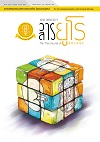Aluminium step wedge as a measurement to predict the ESWL success rate for solitary upper urinary tract stone
Keywords:
lithotripsy, kidney calculi, ureteral calculi, and urolithiasis, สลายนิ่ว, นิ่วไต, นิ่วท่อไต, นิ่วระบบปัสสาวะAbstract
Objective: To describe an objective method for evaluating kidney stone radiopacity for use in the selection of cases suitable for extracorporeal shock wave lithotripsy (ESWL).Materials and Methods: We recruited 55 adult patients with a solitary 0.5-2 cm renal pelvic stone or proximal ureteral stone. All patients underwent routine plain KUB, and an aluminum step wedge was adapted before x-ray exposure. This plain KUB was digitized using Fuji computed radiography. Fuji computed radiography can evaluate the gray level of the stone and each of the 11 steps of the Al step wedge. This allows radiographic stone density to be expressed in mm aluminum equivalent (mm Al Eq).
Results: Stone density on plain KUB was 3 to 26.7 mm aluminum equivalent. The 16 patients in whom ESWL failed were found to have stones of a significantly higher density than the stones found in patients with complete stone fragmentation (mean ± SD 16.69 ± 5.46 vs 10.65 ± 5.28 mm aluminum equivalent, p-value<0.001). There was also a positive correlation between stone radiopacity in mm aluminum equivalent.
Conclusion: The aluminum step wedge with plain KUB provides a good reference for objectively assessing the radiopacity of renal calculi or proximal ureteral calculi.
การทำนายผลสำเร็จของการสลายนิ่วชนิดก้อนเดี่ยวในระบบปัสสาวะส่วนบนโดยใช้ Aluminium step wedge
สิริชัย พฤทธิ์สกุล*, ภควัฒน์ ระมาตร์*, อำไพ อุไรเวโรจนากร**, ไชยยงค์ นวลยง*, สุนัย ลีวันแสงทอง*, สิทธิพร ศรีนวลนัด*, ธวัชชัย ทวีมั่นคงทรัพย์*, บรรณสิทธิ์ ไชยประสิทธิ์*,
ธีระพล อมรเวชสุกิจ*, ศิรส จิตประไพ*, กิตติพงษ์ พินธุโสภณ*, สุชาย สุนทราภา*, พิชัย ศุจิจันทรรัตน์*
*สาขาวิชาศัลยศาสตร์ยูโรวิทยา ภาควิชาศัลยศาสตร์ คณะแพทยศาสตร์ศิริราชพยาบาล มหาวิทยาลัยมหิดล
**ภาควิชารังสีวิทยา คณะแพทยศาสตร์ศิริราชพยาบาล มหาวิทยาลัยมหิดล
บทคัดย่อ
วัตถุประสงค์: อธิบายวิธีประเมินความเข้มของนิ่วไต เพื่อเลือกผู้ป่วยที่เหมาะสมต่อการสลายนิ่ว
ผู้ป่วยและวิธีการศึกษา: ศึกษาในผู้ป่วย 55 ราย ที่มีนิ่วเดี่ยวขนาด 0.5-2 เซนติเมตรในกรวยไต หรือท่อไตส่วนบน โดยผู้ป่วยทุกรายได้รับการตรวจทางรังสีด้วยฟิล์มดิจิตอล KUB โดย Fuji computed radiography และใช้ aluminum step wedge เพื่อการเปรียบเทียบความเข้มของนิ่วกับ aluminium step wedge ซึ่งจำแนกเป็น11 ระดับความเข้ม (mm aluminum equivalent)
ผลการศึกษา: ความเข้มของนิ่วจากฟิล์ม KUB มีค่า 3-26.7 mm aluminum equivalent โดยผู้ป่วย 16 รายที่สลายนิ่วไม่สำเร็จพบว่ามีความเข้มของนิ่วสูงกว่าผู้ป่วยที่สลายนิ่วสำเร็จ (mean ± SD, 16.69 ± 5.46 และ 10.65 ± 5.28mm aluminum equivalent, p-value < 0.001) การศึกษานี้พบว่ามี positive correlation ของความเข้มนิ่วกับ mm aluminum equivalent
สรุป: การใช้ aluminum step wedge สามารถใช้เป็นค่าเปรียบเทียบที่เชื่อถือได้สำหรับการประเมินความเข้มของนิ่วไต หรือนิ่วท่อไตส่วนบน
Downloads
Published
2013-12-30
How to Cite
Prutsakul, S., Ramart, P., Uraiverotchanakorn, A., Nualyong, C., Leewansangtong, S., Srinualnad, S., Taweemonkongsap, T., Chaiyaprasithi, B., Amornvesukit, T., Jitpraphai, S., Phinthusophon, K., Soontrapa, S., & Sujijantararat, P. (2013). Aluminium step wedge as a measurement to predict the ESWL success rate for solitary upper urinary tract stone. Insight Urology, 34(2), 19–28. retrieved from https://he02.tci-thaijo.org/index.php/TJU/article/view/63141
Issue
Section
Original article



